Abstract
Fast prediction modeling via proper orthogonal decomposition method combined with Galerkin projection is applied to incompressible single-phase fluid flow in porous media. Cases for different configurations of porous media, boundary conditions and problem scales are designed to examine the fidelity and robustness of the model. High precision (relative deviation 1.0 × 10−4% ~ 2.3 × 10−1%) and large acceleration (speed-up 880 ~ 98454 times) of POD model are found in these cases. Moreover, the computational time of POD model is quite insensitive to the complexity of problems. These results indicate POD model is especially suitable for large-scale complex problems in engineering.
1 Introduction
Fluid flow in porous media is a very important physical phenomenon in many aspects of engineering, such as catalytic reaction in chemical engineering [1], transport of oil/gas/water in petroleum engineering [2], etc. Numerical simulation is needed to predict the flow details [3]. This usually leads to numerous simulations and long-time iterations of a large-partial-differential-equation system per simulation [4–9]. Therefore, the total computational time is usually very long and as a result this type of simulation is not practical for the demands of fast prediction in engineering.
Proper orthogonal decomposition (POD) is an efficient method for reducing the computational time through Galerkin projection with good precision [10]. It has been successfully used in wide range of physics and engineering problems, such as turbulent flow [11, 12], heat transfer [13, 14], oil transportation [15], etc. Thus, the utilization of POD-Galerkin method can be expected to greatly increase the efficiency of simulation in porous media. Although POD method for flow in subsurface porous media was discussed in reference, emphasis was mainly on precision [16–18] rather than acceleration. In this paper, we demonstrate high acceleration and precision of POD-Galerkin model for incompressible single-phase flow in porous media via a series of numerical cases. For statement convenience, we only discuss two-dimensional cases here.
2 Establishment of the POD-Galerkin Model
2.1 Description of the Original Governing Equations
Incompressible single-phase flow in porous media are described by the mass balance equation (Eq. (1)) and the Darcy’s law (Eq. (2)) as follows:
where
Eq. (3) shows that computational time is primarily used in the computation of pressure, usually requiring long-time iterations for large systems. POD-Galerkin model is a good choice for greatly reducing the computational time of Eq. (3). The main procedure to establish the model will be stated below.
2.2 POD-Galerkin Model
POD method is data dependent so that the first step is collection of samples through computation of governing equations (Eq. (2) and Eq. (3)). Finite difference method (FDM) is used here to obtain discrete equations of the governing equations, which are solved via the Gauss-Seidel iteration method combined with the successive over relaxation method. The samples can be expressed as follows:
where S1, S2, S3, · · · , SN represent the serials of samples, N is the number of samples, L is the number of grid points (including boundary). All the samples compose an L × N sample matrix:
The number of grid points is usually much larger than the number of samples, i.e. L>>N. Thus, the snapshot POD [19, 20] should be used to obtain POD modes:
where ϕn are referred to the POD modes (n = 1~ N), σn and Vn are the singular values and eigenvectors obtained from singular value decomposition (SVD) of matrix STS.
With the known singular values, we can define:
where en is the energy contribution of the nth POD mode to the whole energy spectrum of POD, En is the cumulative energy contribution of the first n POD modes (ϕ1 ~ ϕn) to the whole energy spectrum. The higher energy contributions indicate more features of samples captured by POD modes so as to more importance of these modes. This property will be used to determine the selection of POD modes in Section 3.
With the known modes ϕn, pressure can be reconstructed by the linear combination:
where M(≤ N) is the number of used POD modes, cn are unknown coefficients, independent of space, to be calculated from the POD model. To derive this model, we substitute Eq. (8) to Eq. (3) and obtain:
Project Eq. (9) onto the POD mode ϕm (m = 1~ M):
Simplify Eq. (10) via the integration by part:
The undefined symbols in Eqs. (10) and (11) are illustrated in Fig. 1. Uniform mesh and staggered grid method are utilized with grid number of 100 × 100 and domain size of 100 m × 100 m in this paper.
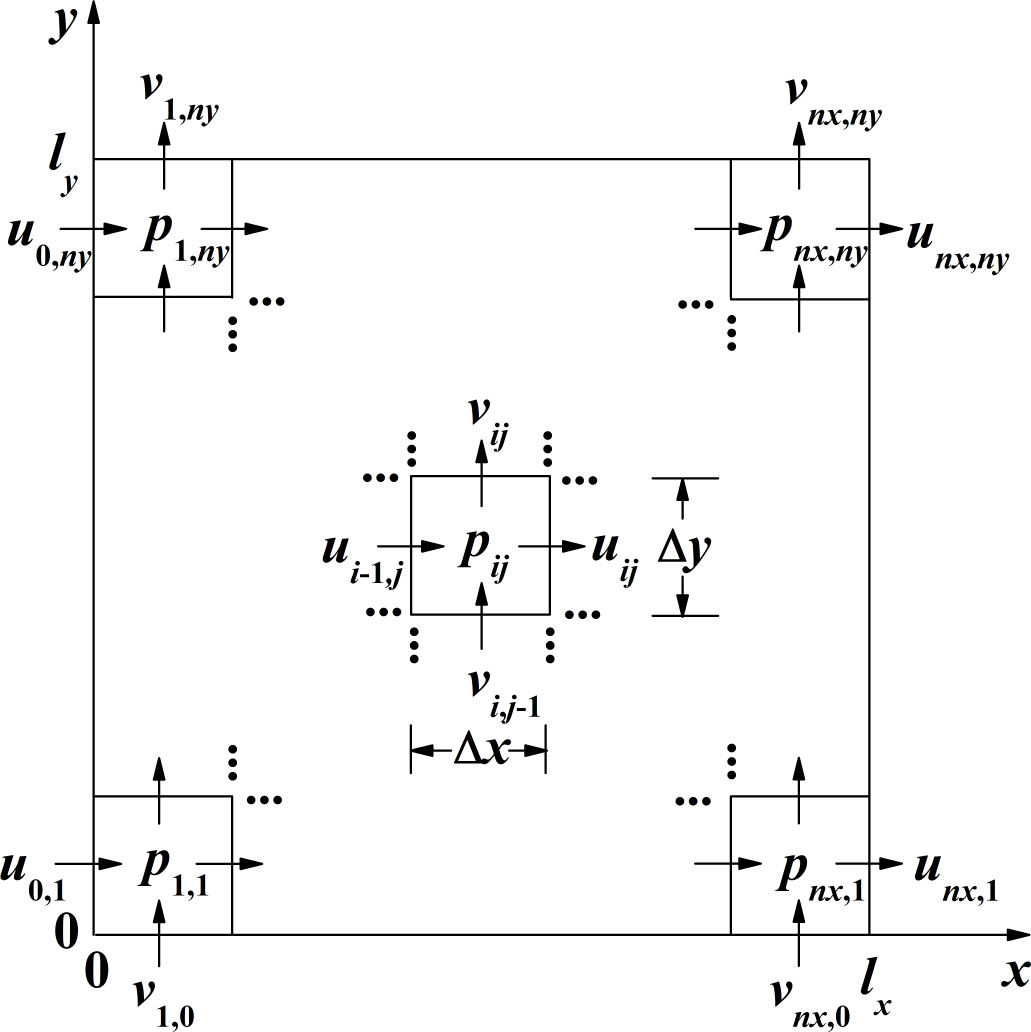
Domain and staggered grid
For a Dirichlet boundary condition (known boundary pressure), any one of the following equations could be used:
For a Neumann boundary condition (known boundary velocity), any one of the following equations could be used:
Combining the Dirichlet and Neumann boundary conditions in Eq. (11), the final expression for POD-Galerkin model is:
where
Dirix and Diriy are 1 for Dirichlet boundaries and 0 for Neumann boundaries.
For a prediction case that is different from samples, the coefficients can be calculated from Eq. (14) so that the pressure under the prediction condition can be calculated directly from Eq. (14) instead of Eq. (3). From the above derivation, we know the dimension of Eq. (14) is much smaller than that of Eq. (3), i.e. M ≤ N ≪ L. Thus, computational time can be reduced largely via POD-Galerkin model.
3 Results and Discussion
In this section, the POD-Galerkin model obtained in Section 2 is applied to incompressible single-phase flow in different types of porous media to examine the precision and acceleration abilities of the model. Precision is measured by the relative deviation:
Acceleration is measured by the ratio:
where pFDM and pPOD are the pressure fields calculated from Eq. (3) via FDM and Eq. (14) & (8) via POD. tFDM and tPOD are corresponding CPU time. ||·|| represents the L1-norm.
3.1 A Homogeneous Isotropic Porous Medium
Firstly, a homogeneous isotropic porous medium is considered. Permeability components are the same over the whole domain with the value of 100 md (1 md = 9.869233 × 10−16 m2). The parameters and boundary conditions are shown in Fig. 2. Each boundary pressure takes two different values: p1 = {50, 60} mH2O, p2 = {20, 40} mH2O (1 mH2O = 9800 Pa). Thus, the number of the samples is 2 × 2 = 4.
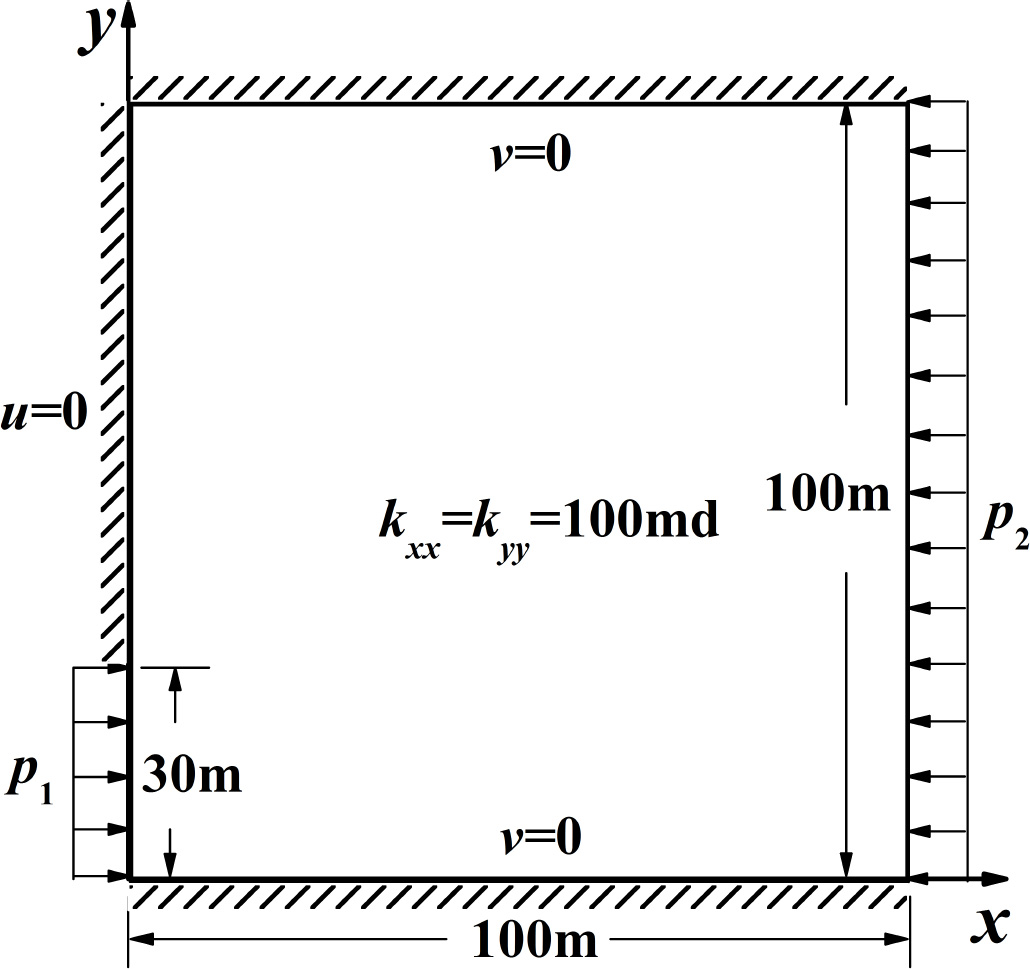
A homogeneous isotropic porous medium
According to Section 2, the maximum number of POD modes is equivalent to the number of samples, i.e. four in this case. The selection of the mode number depends on the actual precision of sample reconstruction. The precisions using different number of POD modes are shown in Table. 1. It is obvious that the optimal number of POD modes is two with the relative deviation as low as 0%~ 2 × 10−4%. The inclusion of ϕ3 and ϕ4 generates very large deviations. The reason is analyzed in Fig. 3 and Table. 2. In Fig. 3, the smooth distributions of modes ϕ1 and ϕ2 refect the sample distribution correctly (Fig. 3(a) & 3(b)) while the fluctuated distributions of modes ϕ3 and ϕ4 indicate the unphysical numerical errors because flows in porous media are low-speed laminar flow without fluctuations. This is further verified in Table. 2 that ϕ3 and ϕ4 do not contain any energy indicating that they do not contain any information about the samples. These two modes are only numerical errors produced by the SVD. The sole inclusion of ϕ1 could not generate accurate enough reconstructed results (e = 2.82% ~ 10.11% in Table. 1) although its energy contribution is very high (en = 99.35%). The inclusion of ϕ2 supplements a small energy contribution (en = 0.65%) to make the POD model capture the whole important information (En = 100%) and promote model precision largely (e = 0% ~ 2 × 10−4% in Table. 1). Thus, ϕ2 cannot be neglected even if its energy contribution is quite lower than ϕ1. The same situations also occur in Sections 3.2 ~ 3.5 according to the computational results so that the discussion on the selection of POD modes will not be repeated in the following sections and ϕ1 and ϕ2 will be used directly.
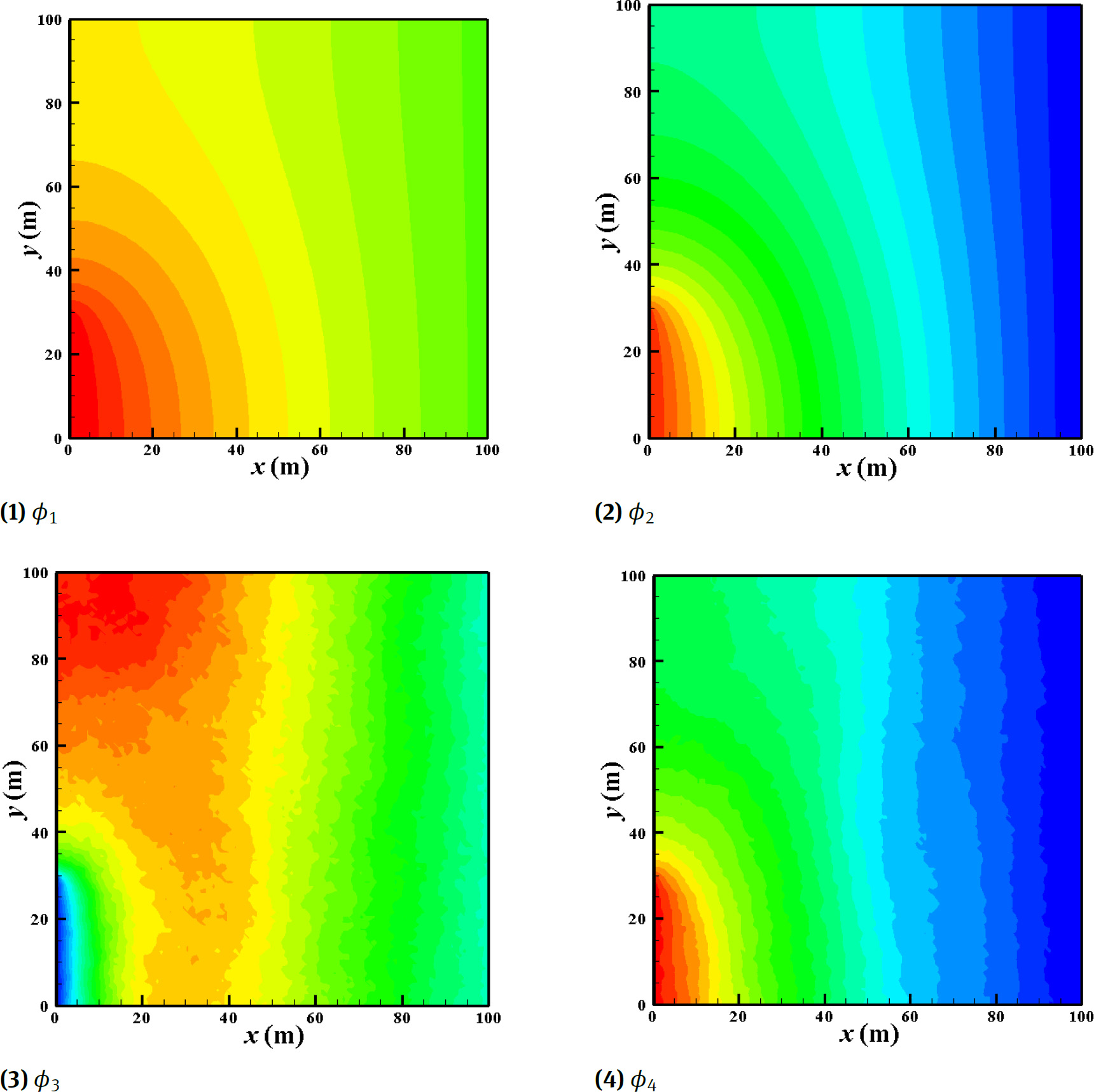
Distribution of POD modes
Relative deviation of sample reconstruction
| M | S1 | S2 | S3 | S4 |
|---|---|---|---|---|
| 1 | 6.75% | 6.13% | 10.11% | 2.82% |
| 2 | 2 × 10−4% | 0% | 2 ×10−4% | 1 × 10−4% |
| 3 | 84.35% | 70.00% | 88.09% | 73.69% |
| 4 | 84.36% | 70.04% | 88.09% | 73.72% |
Energy contribution of the POD modes
| n | 1 | 2 | 3 | 4 |
|---|---|---|---|---|
| en | 99.35% | 0.65% | 0% | 0% |
| En | 99.35% | 100% | 100% | 100% |
To validate the precision of POD model for predicting cases different from the samples, prediction conditions are designed as p1 = {10, 20, 30, 40, 50, 60, 70, 80, 90, 100} mH2O, p2 = {5, 15, 25, 35, 45, 55, 65, 75, 85, 95} mH2O so that the number of prediction cases is 10 × 10 = 100. The relative deviations of 100 cases are shown in Fig. 4 with the maximum value of 4.0 × 10−4% and the minimum value of 0%, indicating good performance of solutions globally. Three typical cases (a, b, c) are selected to show the local solutions of the flow field. The comparisons are shown in Fig. 5. Local solutions of p, u, v using POD coincide very well with those using FDM, no matter whether the boundary conditions fall within (a) or out of (b, c) the sample scope. Even if the boundary condition of case c (p1 < p2) is opposite to that of samples (p1 > p2), the deviation is also small enough. Therefore, the POD model is proved to be very accurate for the homogeneous isotropic porous medium.
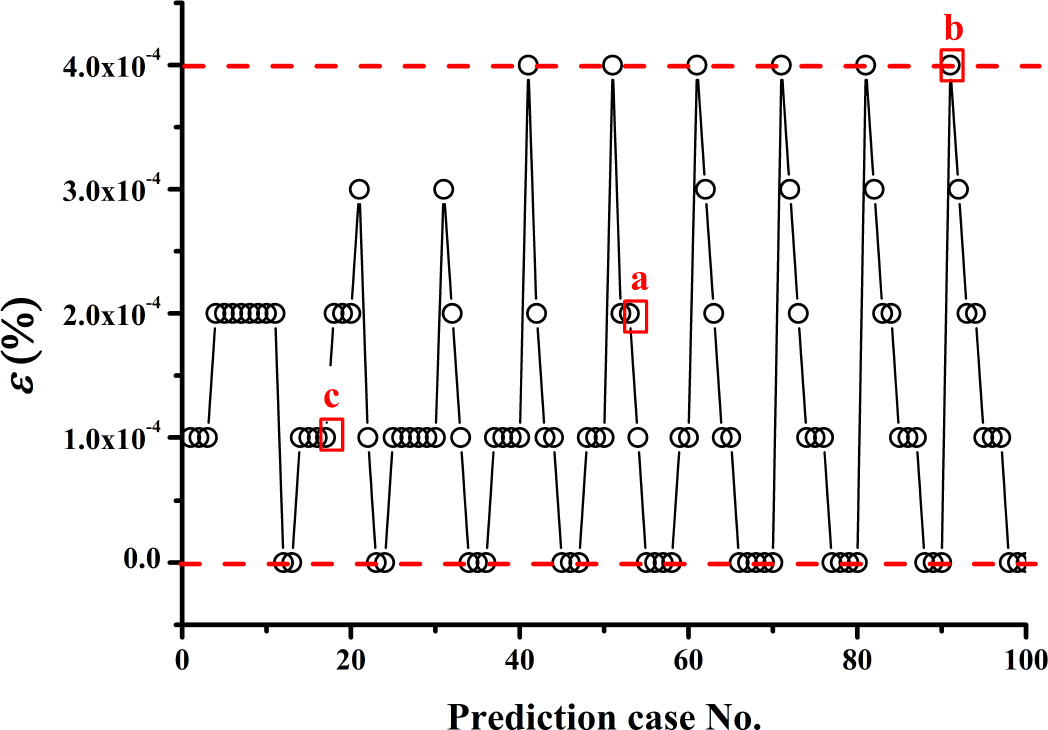
Relative deviation of the prediction cases for a homogeneous isotropic porous medium
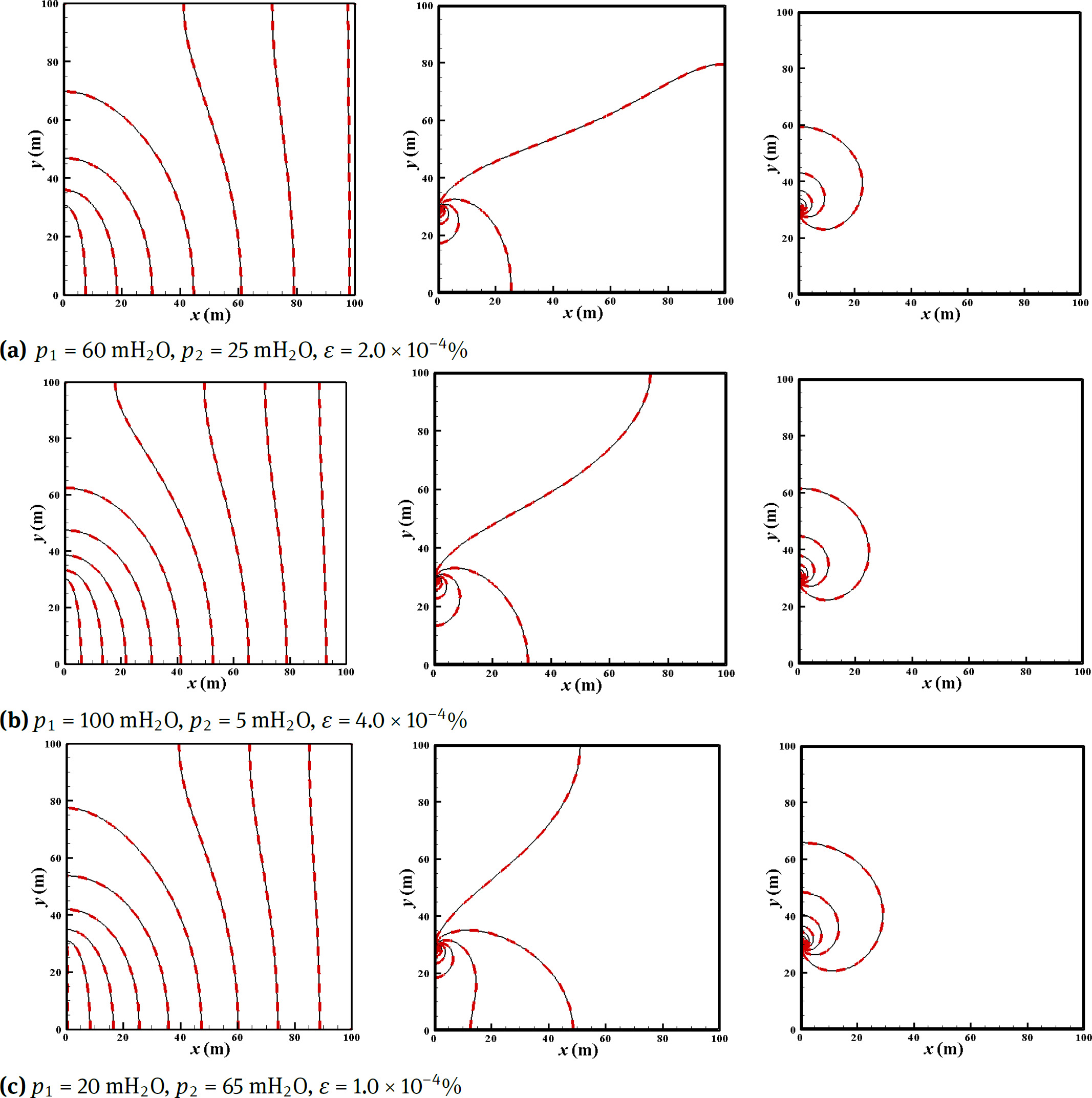
Comparison of flow fields for 3 typical prediction cases for a homogeneous isotropic porous medium: from left to right are p, u, v respectively; black solid line-FDM, red dotted line-POD
To validate the computational speed of the POD model, computational time is compared in Table. 3. The computational time of the training stage (both the 4 sample cases and the SVD) only costs once for the POD model. Once the training stage is completed, we can use the POD model to predict any number of cases without further sampling and decomposition. Thus, the one-time cost of training time should not be considered into the acceleration ratio of POD model, even if it is small. For the 100 prediction cases, the computational times of FDM and POD are 678 s and 0.2s respectively. The acceleration ratio is high (3390), indicating excellent acceleration ability of POD model.
Computational time comparison for a homogeneous isotropic porous medium
| Training | Sampling Time (4 cases) | 27s | One-time |
|---|---|---|---|
| Stage | Decomposition Time | 3.6s | cost |
| Prediction | FDM (100 cases) | 678s | r = 678/ |
| Stage | POD (100 cases) | 0.2s | 0.2 = 3390 |
3.2 A Homogeneous Anisotropic Porous Medium
In this section, a homogeneous anisotropic porous medium is considered as shown in Fig. 6. The permeability tensor is unique all over the domain, but the component kxx is 100 times larger than component kyy. Different boundary conditions are adopted to avoid particularity. Four sample cases are taken with the same boundary pressures of Section 3.1. The 100 prediction cases are designed with the boundary pressures:
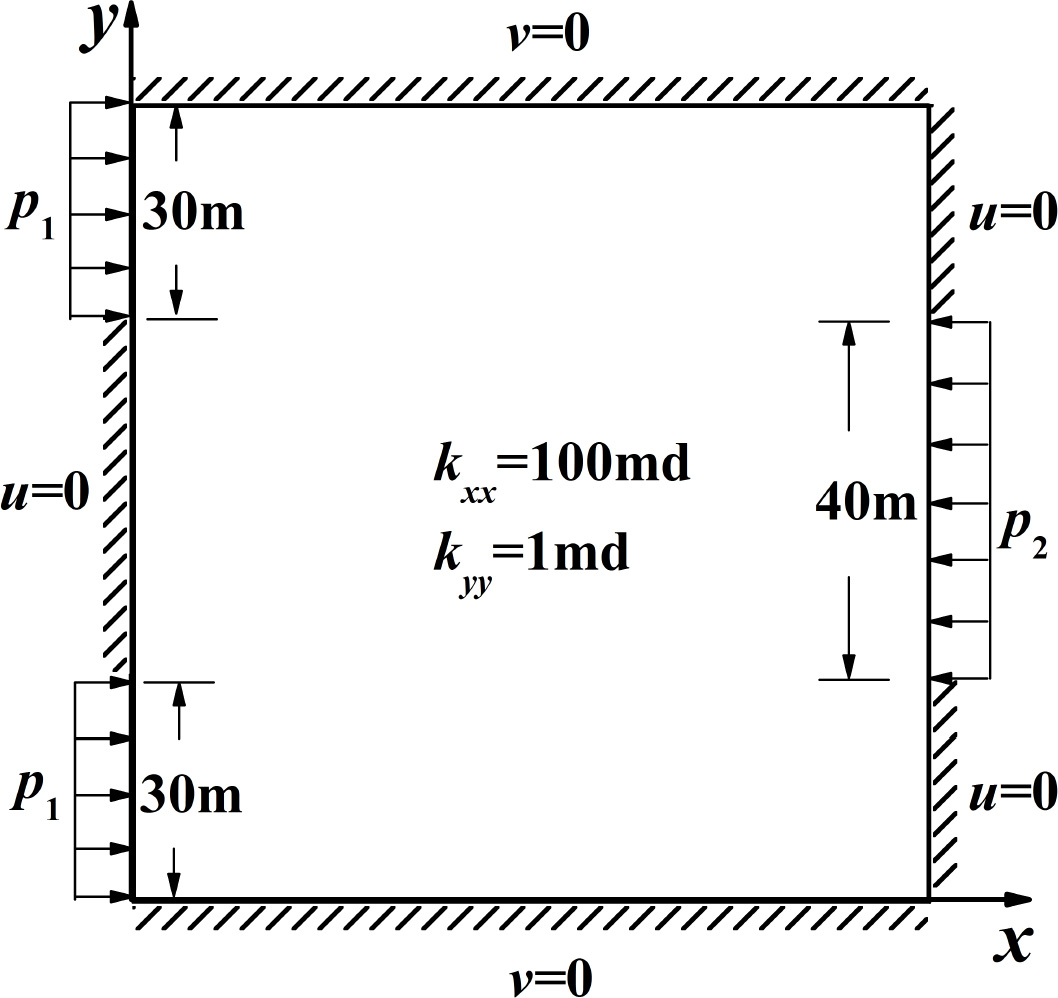
A homogeneous anisotropic porous medium
p1 = {10, 20, 30, 40, 50, 60, 70, 80, 90, 100} mH2O,
p2 = {15, 25, 35, 45, 55, 65, 75, 85, 95, 105} mH2O.
Fig. 7 shows the high precision of POD model for 100 cases. The relative deviations are low (1.0 × 10−4% ~ 5.2 × 10−3%). The precision is further examined using two cases (a, b) with the maximum and minimum deviations. For these cases, POD results agree very well with FDM results (as shown in Fig. 8). Thus, POD model is very accurate for homogeneous anisotropic porous medium.
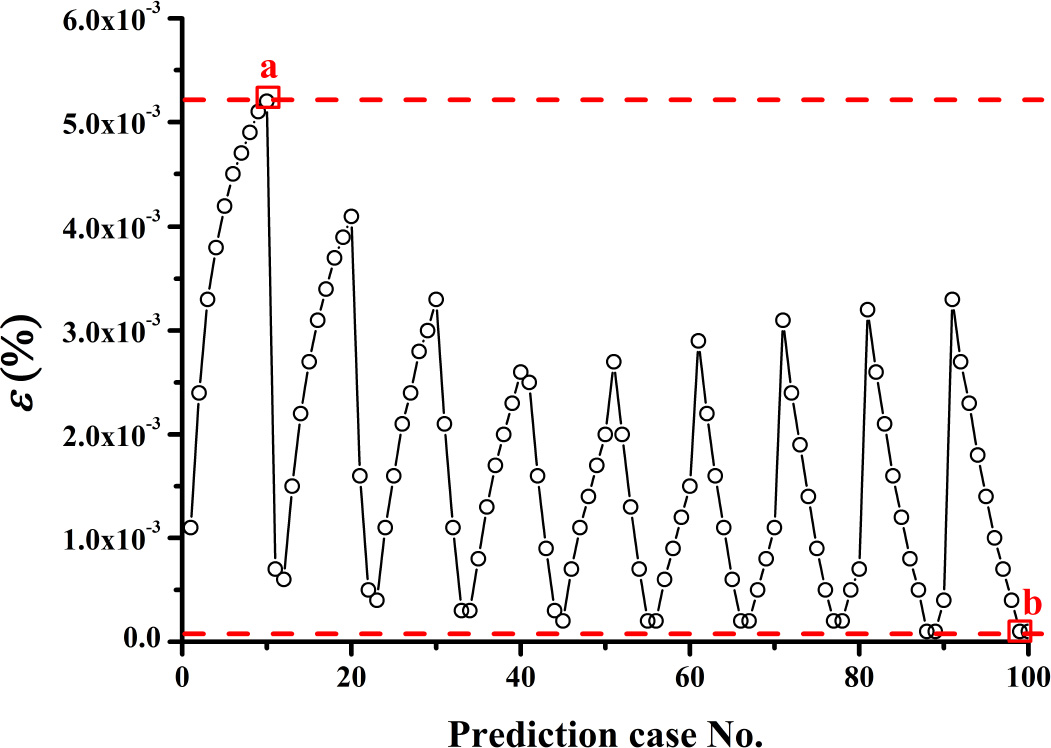
Relative deviation of the prediction cases for a homogeneous anisotropic porous medium
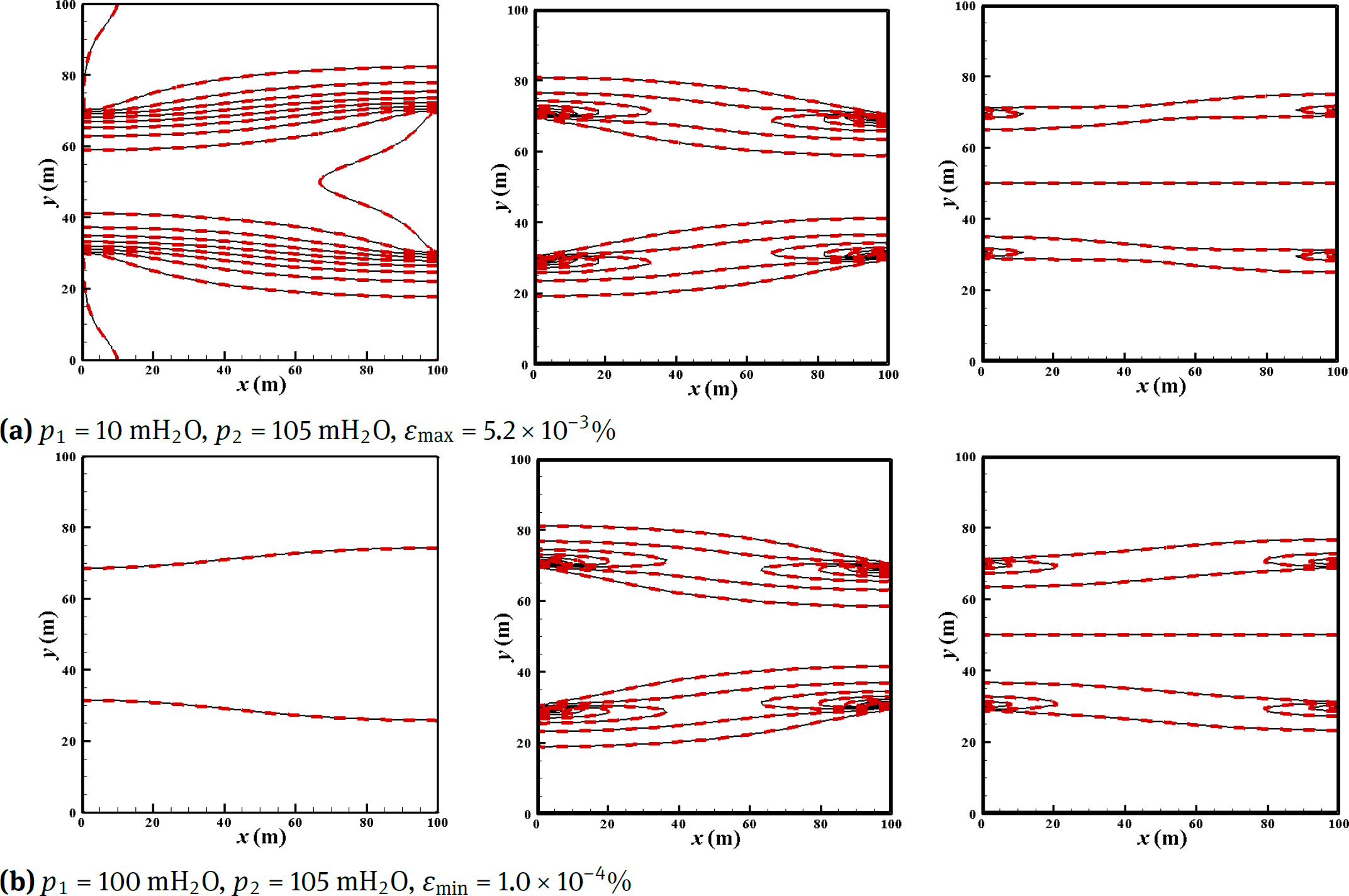
Comparison of flow fields for 2 typical prediction cases for a homogeneous anisotropic porous medium: from left to right are p, u, v respectively; black solid line-FDM, red dotted line-POD
For the 100 prediction cases, the computational times are compared in Table. 4 for FDM and POD. The acceleration ratio is still very high (r = 2300), showing the good acceleration ability of the POD model.
Computational time comparison for a homogeneous anisotropic porous medium
| Training | Sampling Time (4 cases) | 26s | One-time |
|---|---|---|---|
| Stage | Decomposition Time | 0.2s | cost |
| Prediction | FDM (100 cases) | 621s | r = 621/ |
| Stage | POD (100 cases) | 0.27s | 0.27 = 2300 |
3.3 An Inhomogeneous Isotropic Porous Medium
In this section, an inhomogeneous isotropic porous medium is designed as shown in Fig. 9. The distribution of permeability is not uniform with a small value in the “H”-shape zone and a large value in other zone, but the two components kxx and kyy are always equal to each other. Sample cases are designed as p1 = {50, 55} mH2O, p2 = {60, 65} mH2O. Prediction cases are designed as p1 = {0, 10, 20, 30, 40, 50, 60, 70, 80, 90} mH2O, p2 = {10, 20, 30, 40, 50, 60, 70, 80, 90, 100} mH2O. It should be noticed that there are no flows for the 9 cases when p1 = p2 so those are not discussed here. Therefore, the total effective prediction cases must be 10 × 10 - 9 = 91.
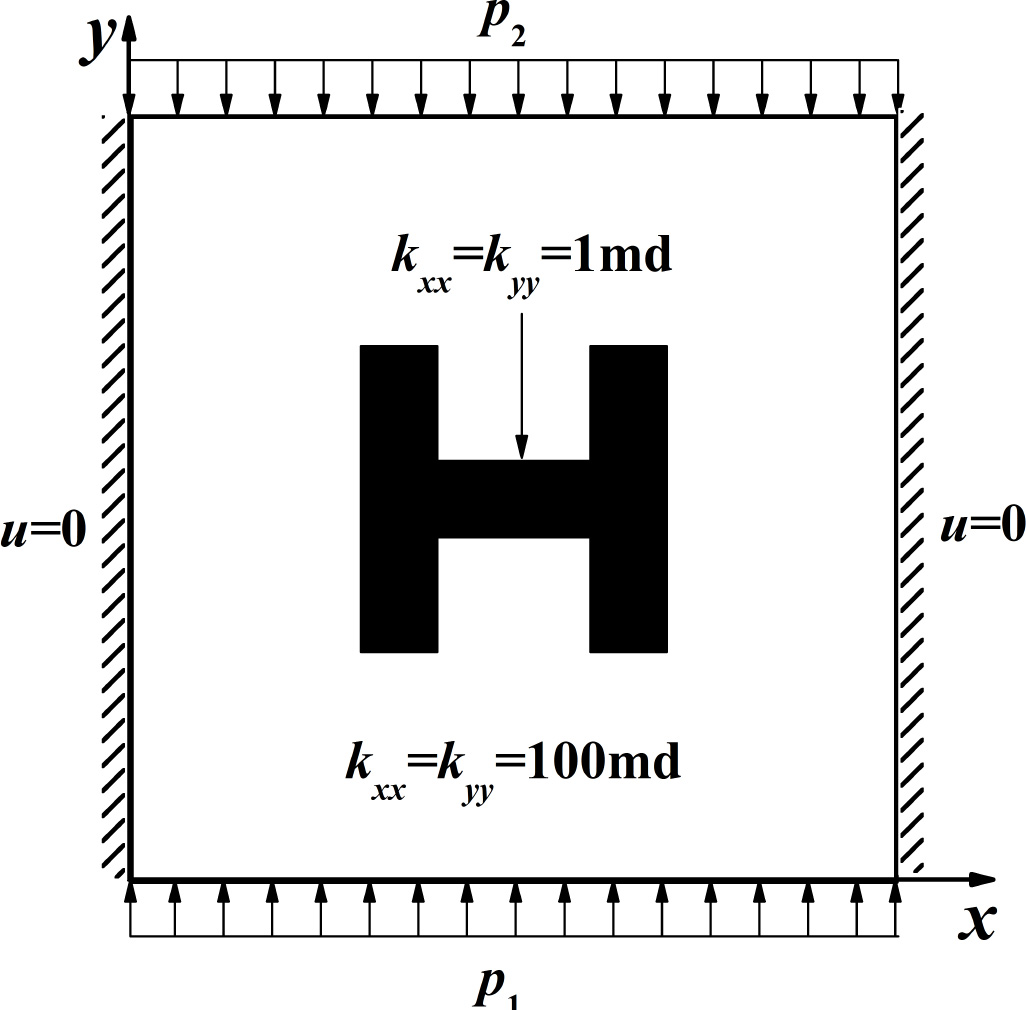
An inhomogeneous isotropic porous medium
With the 2 POD modes extracted from the 4 samples, predictions for 91 cases are made. The relative deviations are very low (7.0 × 10−4%~ 1.4 × 10−2%) as shown in Fig. 10. Pressure and velocity coincide very well with each other for both POD and FDM in the two cases with the maximum and minimum deviations (Fig. 11). Thus, POD model is again proven to be very accurate for inhomogeneous isotropic porous medium.
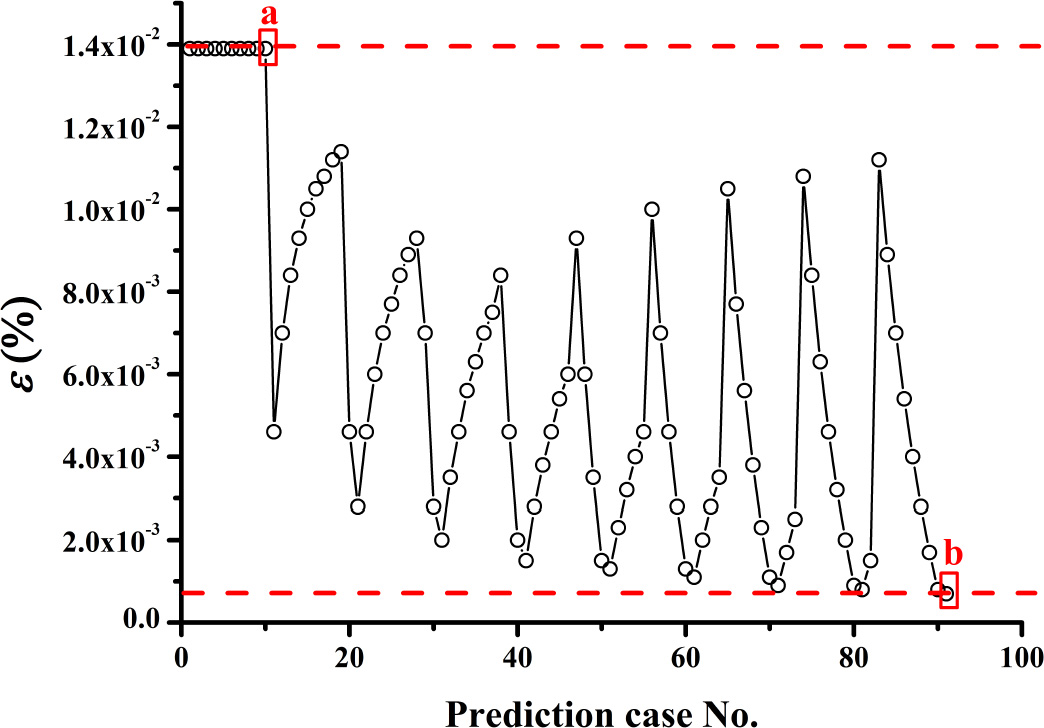
Relative deviation of the prediction cases for an inhomogeneous isotropic porous medium
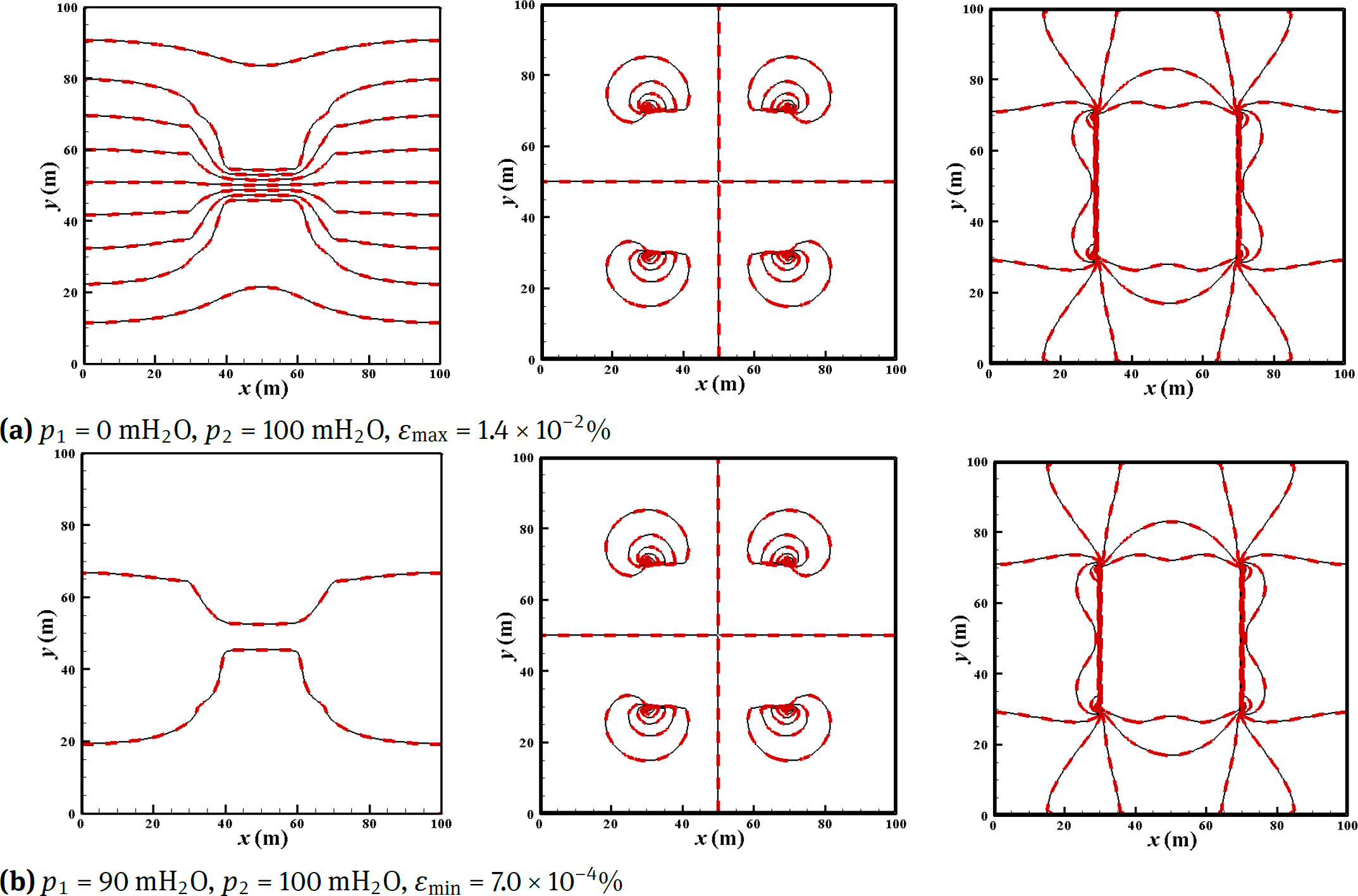
Comparison of flow fields for 2 typical prediction cases for an inhomogeneous isotropic porous medium: from left to right are p, u, v respectively; black solid line-FDM, red dotted line-POD
Table. 5 shows the acceleration ratio of the POD model decreases to 880. The decrease is due to the shorter computational time for FDM caused by different permeability field and boundary conditions. Nevertheless, the acceleration ratio is still attractive.
Computational time comparison for an inhomogeneous isotropic porous medium
| Training | Sampling Time (4 cases) | 12s | One-time |
|---|---|---|---|
| Stage | Decomposition Time | 3.2s | cost |
| Prediction | FDM (91 cases) | 264s | r = 264/ |
| Stage | POD (91 cases) | 0.3s | 0.3 = 880 |
3.4 An Inhomogeneous Anisotropic Porous Medium
To examine the POD model in a more complex case, we let kxx > kyy in the “H”-shape zone and kxx < kyy in the other zone so that an inhomogeneous anisotropic porous medium is designed as shown in Fig. 12. All other sampling and prediction conditions are the same as Section 3.3.
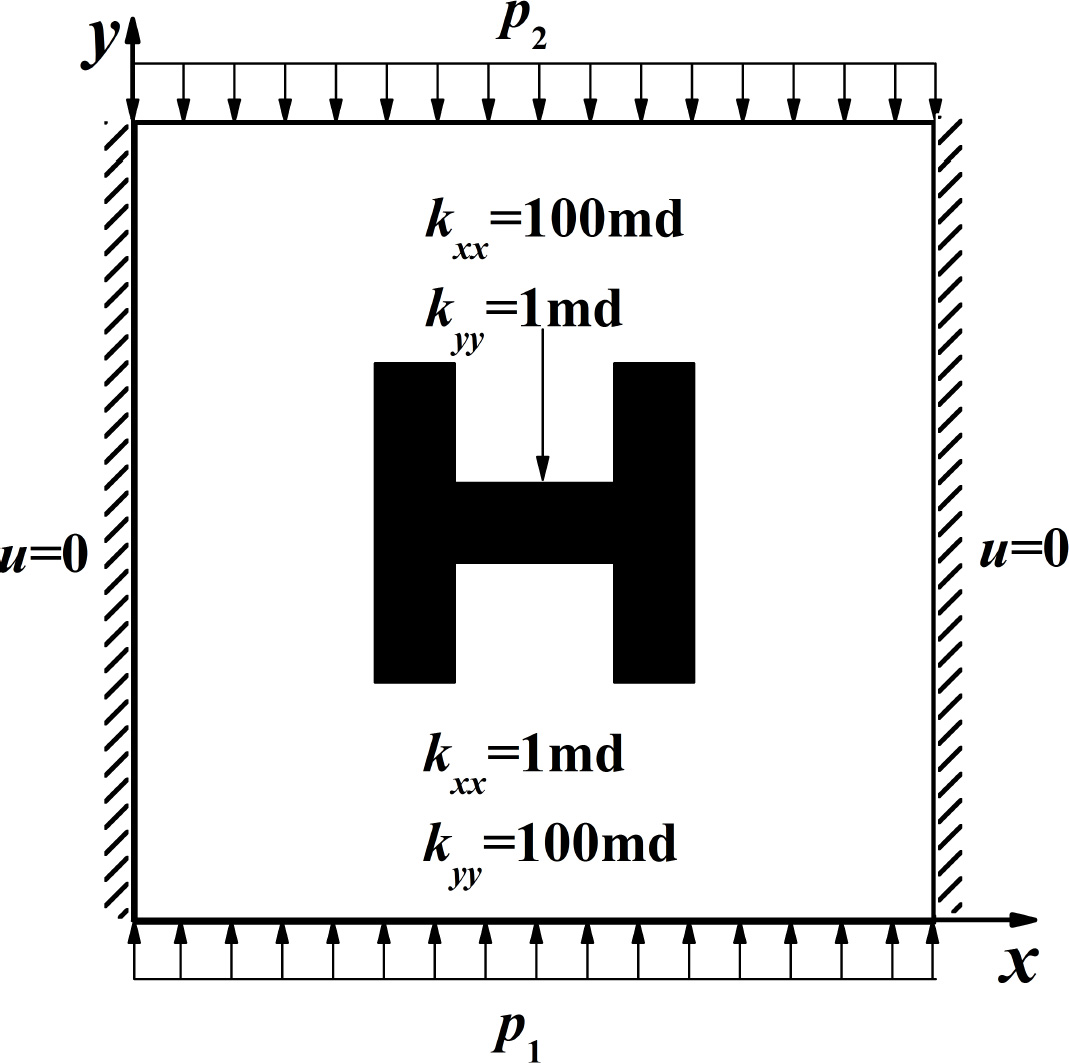
An inhomogeneous anisotropic porous medium
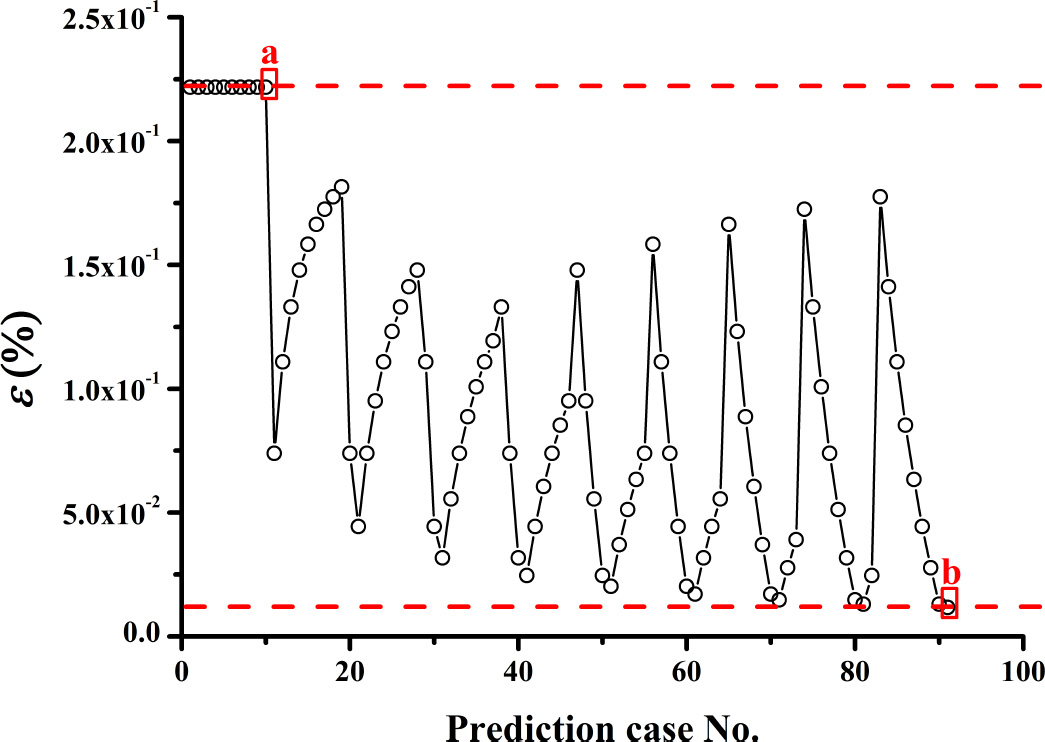
Relative deviation of the prediction cases for an inhomogeneous anisotropic porous medium
The relative deviations of the prediction cases are apparently larger than the previous situations, indicating that the precision of POD model may decrease along with the increasing complexity of the problems. However, the precision is still high (ɛ = 1.2 × 10−2% ~ 2.2 × 10−1%) in Fig. 13. The flow fields still coincide with each other very well for both POD and FDM results, in the two cases with maximum and minimum deviations (Fig. 14). Thus, the POD model has also proven to be very accurate for inhomogeneous isotropic porous medium.
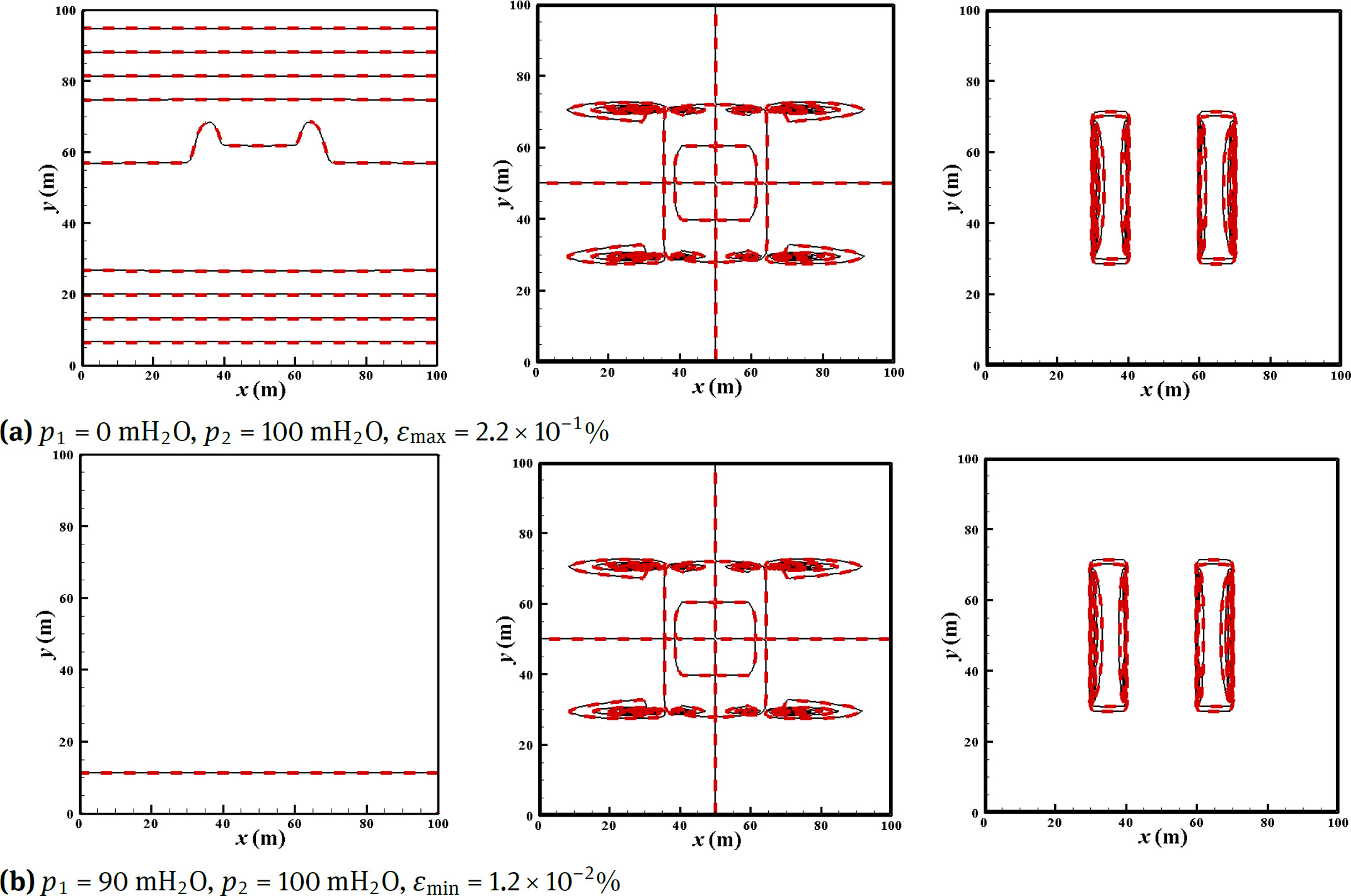
Comparison of flow fields for 2 typical prediction cases for an inhomogeneous anisotropic porous medium: from left to right are p, u, v respectively; black solid line-FDM, red dotted line-POD
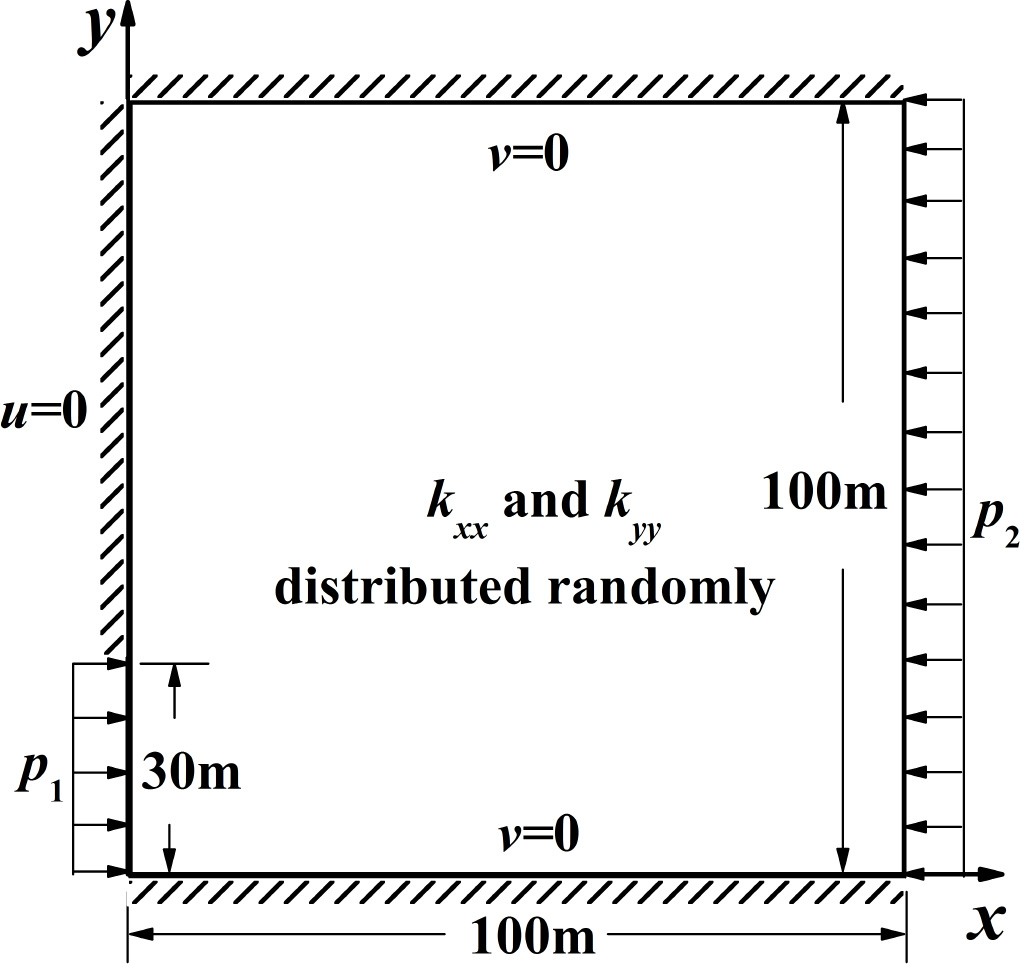
A random porous medium
Table. 6 shows the acceleration ratio of the prediction cases. It is 98454, which exceeds all other cases in the above sections. The extremely high acceleration ratio is due to longer computational time for FDM due to much higher complexity of the problem.
Computational time comparison for an inhomogeneous anisotropic porous medium
| Training | Sampling Time (4 cases) | 543s One-time |
|---|---|---|
| Stage | Decomposition Time | 0.14s cost |
| Prediction | FDM (91 cases) | 12799s r = 12799/ |
| Stage | POD (91 cases) | 0.13s 0.13 = 98454 |
3.5 A Random Porous Medium
From the comparisons in Sections 3.1 ~ 3.4, we confirmed that POD model has high fidelity in precision and large acceleration in computational time for either homogeneous or inhomogeneous and either isotropic or anisotropic porous media. However, the computational settings are basically ideal, e.g. the “H”-shaped permeability distribution. Permeability fields in real engineering are more complex than these structures. In order to achieve stronger conclusions, we use randomly distributed, inhomogeneous and anisotropic permeability field and recall other settings in the case in Section 3.1. The domain and parameters are shown in Fig. 15 while the permeability fields are shown in Fig. 16.Two components of permeability are even in different ranges: kxx for 1 md ~ 10 md and kyy for 10 md ~ 100 md. The sampling conditions are: p1 = {30, 60} mH2O, p2 = {20, 80} mH2O. The prediction conditions are:
p1 = {10, 20, 30, 40, 50, 60, 70, 80, 90, 100, 110} mH2O,
p2 = (0, 15, 30, 45, 60, 75, 90, 105, 120, 135) mH2O.
Computational time comparison for a random porous medium
| Training | Sampling Time (4 cases) | 109s | One-time |
|---|---|---|---|
| Stage | Decomposition Time | 0.2s | cost |
| Prediction | FDM (107 cases) | 3266s | r = 3266/ |
| Stage | POD (107 cases) | 0.23s | 0.23 = 14200 |
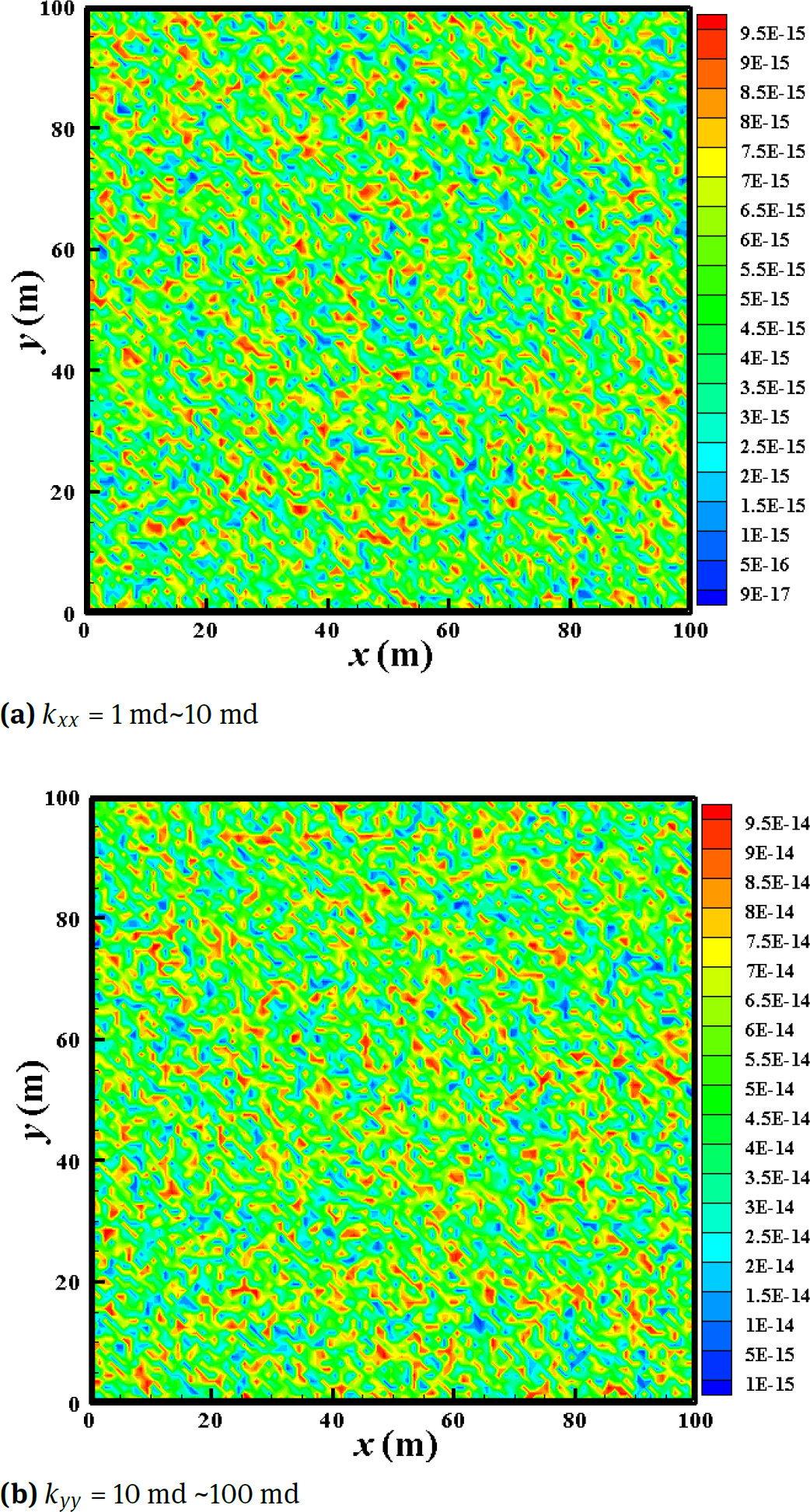
Random distribution of the inhomogeneous-anisotropic permeability field
As shown in Fig. 17, the relative deviations are 4.5 × 10−3% ~ 2.3 × 10−1% even if 107 prediction cases are predicted by only 2 POD modes for the random permeability field. This overall precision is high enough to be accepted in engineering. To identify local precision, 4 typical cases (a, b, c, d) among these 107 cases are selected to compare the pressure field and the velocity field obtained by POD and FDM. If the same style of the previous comparison (e.g. style in Fig. 5, Fig. 8, Fig. 11, Fig. 14) is adopted, the local details cannot be recognized clearly. Therefore, we change to a new comparison style in Fig. 18, where the figures on the first row represent results by FDM while the figures on the second row represent the results by POD. The comparison shows that POD results agree very well with the FDM results, even though the prediction conditions of the 4 cases are quite different from the sampling conditions. Acceleration ratio on the computational time is also surprisingly high (r = 14200).
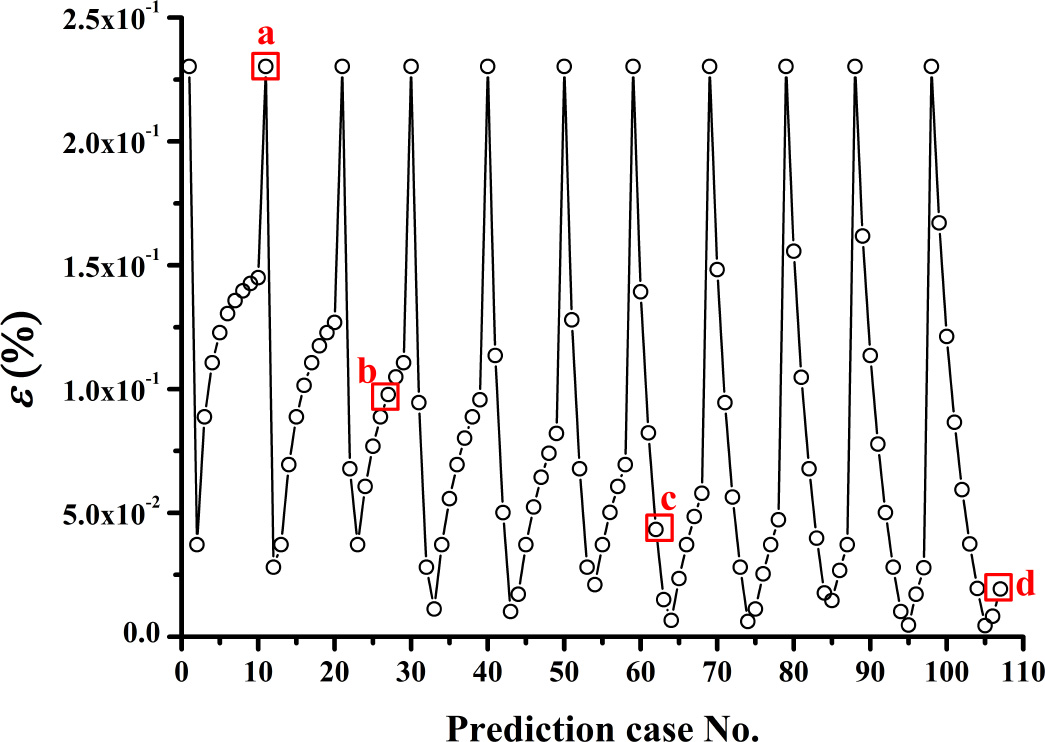
Relative deviation of the prediction cases for a random porous medium
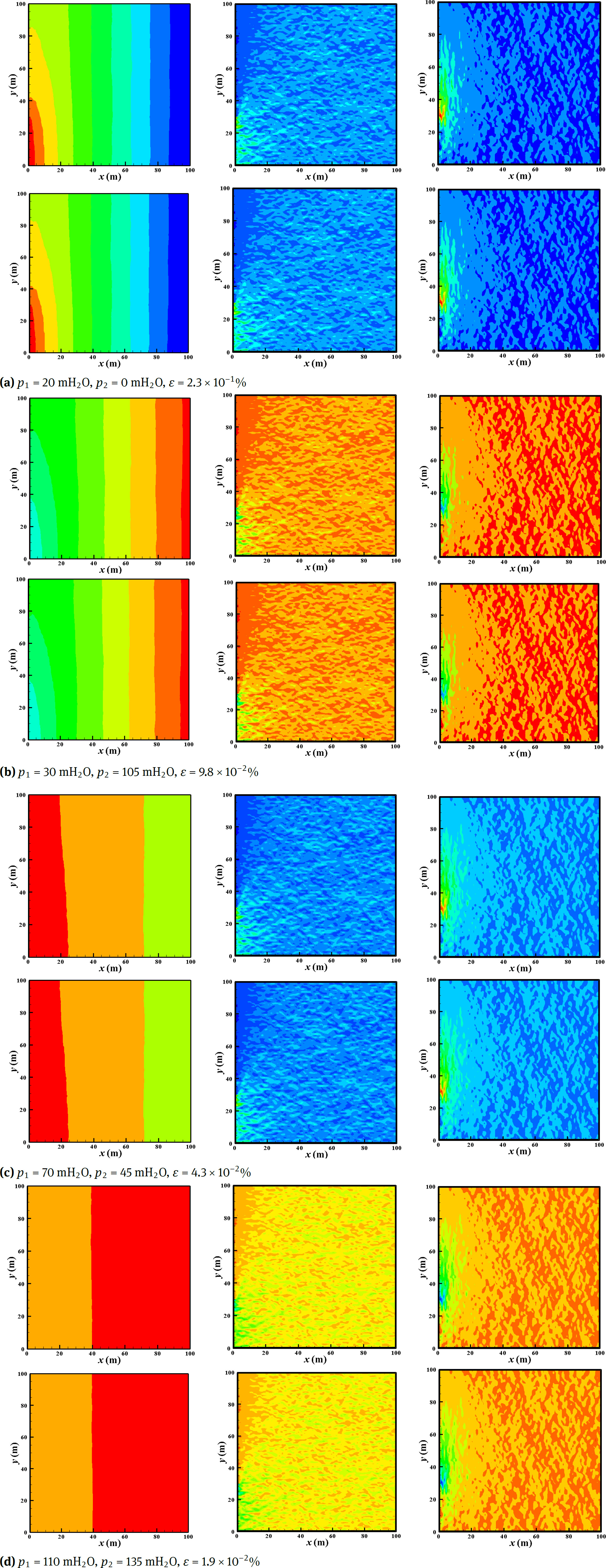
Comparison of flow fields for 4 typical prediction cases for a random porous medium: from left to right are p, u, v respectively; first row-FDM, second row-POD
4 Conclusion
POD-Galerkin modeling method is successfully applied to incompressible single-phase flow in porous media. Precision and acceleration of the model are discussed under different permeability and boundary settings. Our primary conclusions are as follows:
The acceleration ratio is very large with very high precision for fluid flows in different types of porous media (r = 880~ 98454 and ɛ = 1.0 × 10−4% ~ 2.3 × 10−1%).
The computational time of FDM is very sensitive to complexity of problems such as configuration of permeability, the number of prediction cases, boundary conditions, etc. It is usually higher for more complex porous media (264 s ~ 12799 s). However, the computational time of POD is quite insensitive to the complexity of problems. It is only in a very narrow range (0.13 s ~ 0.3 s) for cases with configuration of permeability, the number of prediction cases and boundary condition quite different from each other. The reason for this phenomenon is that complexity strongly affects the iteration process of large equation systems in FDM (Eq. (3)) but the effects of complexity on much smaller equation systems in POD (Eq. (14)) is very weak.
According to (1) and (2), the POD-Galerkin model has potential to satisfy the demands of fast prediction in engineering where complex porous media are usually encountered.
Acknowledgement
The work presented in this paper has been supported by National Natural Science Foundation of China (NSFC) (No.51576210, No.51476073, No.51325603), Science Foundation of China University of Petroleum-Beijing (No.2462015BJB03, No.2462015YQ0409, No. C201602) and also supported in part by funding from King Abdullah University of Science and Technology (KAUST) through the grant BAS/1/1351-01-01.
References
[1] Li X., Chen J., Xu M., Huai X., Xin F., Cai J., Lattice Boltzmann simulation of catalytic reaction in porous media with buoyancy, Appl. Therm. Eng., 2014, 70, 586-592.10.1016/j.applthermaleng.2014.04.034Search in Google Scholar
[2] Salehi-Shabestari A., Ahmadpour A., Raisee M., Sadeghy K., Flow and displacement of waxy crude oils in a homogenous porous medium: a numerical study, J. Non-Newton. Fluid Mech., 2016, 235, 47-63.10.1016/j.jnnfm.2016.07.005Search in Google Scholar
[3] Chen J., Chen Z., Three-dimensional superconvergent gradient recoveryon tetrahedral meshes, Int.J.Numer. Meth. Eng., 2016, 10.1002/nme.5229.Search in Google Scholar
[4] Moortgat J., Sun S., Firoozabadi A., Compositional modeling of three-phase flow with gravity using higher-order finite element methods, Water Resour. Res., 2011, 47, W05511.10.1029/2010WR009801Search in Google Scholar
[5] Sun S., Liu J., A locally conservative finite element method based on piecewise constant enrichment of the continuous Galerkin method, SIAM J. Sci. Comput., 2009, 31(4), 2528-2548.10.1137/080722953Search in Google Scholar
[6] Sun S., Wheeler M.F., Analysis of discontinuous Galerkin methods for multicomponent reactive transport problems, Comput. Math. Appl., 2006, 52(5), 637-650.10.1016/j.camwa.2006.10.004Search in Google Scholar
[7] Sun S., Wheeler M.F., A dynamic, adaptive, locally conservative and nonconforming solution strategy for transport phenomena in chemical engineering, Chem. Eng. Commun., 2006, 193(12), 1527-1545.10.1080/00986440600584284Search in Google Scholar
[8] Sun S., Wheeler M.F., Discontinuous Galerkin methods for simulating bioreactive transport of viruses in porous media, Adv. Water Resour., 2007, 30(6-7), 1696-1710.10.1016/j.advwatres.2006.05.033Search in Google Scholar
[9] Wang Y., Sun S., Direct calculation of permeability by high-accurate finite difference and numerical integration methods, Commun. Comput. Phys., 2016, 20(2), 405-440.10.4208/cicp.210815.240316aSearch in Google Scholar
[10] Bergmann M., Bruneau C.H., Iollo A., Enablers for robust POD models, J. Comput. Phys., 2009, 228 (2), 516-538.10.1016/j.jcp.2008.09.024Search in Google Scholar
[11] Wang Y., Yu B., Wu X., Wang P., POD and wavelet analyses on the flow structures of a polymer drag-reducing flow based on DNS data, Int. J. Heat Mass Transf., 2012, 55(17-18), 4849-4861.10.1016/j.ijheatmasstransfer.2012.04.055Search in Google Scholar
[12] Podvin B.,A proper-orthogonal-decomposition-based model for the wall layer of a turbulent channel flow, Phys. Fluids, 2009, 21(1), 94-100.10.1063/1.3068759Search in Google Scholar
[13] Wang Y., Yu B., Cao Z., Zou W., Yu G., A comparative study of POD interpolation and POD projection methods for fast and accurate prediction of heat transfer problems, Int. J. Heat Mass Transf., 2012, 55(17-18), 4827-4836.10.1016/j.ijheatmasstransfer.2012.04.053Search in Google Scholar
[14] Wang Y., Yu B., Sun S., Fast prediction method for steady-state heat convection, Chem. Eng. Technol., 2012, 35(4): 668-678.10.1002/ceat.201100428Search in Google Scholar
[15] Han D., Yu B., Wang Y., Zhao Y„ Yu G., Fast thermal simulation of a heated crude oil pipeline with a BFC-based POD reduced-order model, Appl. Therm. Eng., 2015, 88, 217-229.10.1016/j.applthermaleng.2014.10.017Search in Google Scholar
[16] Ghommem M., Calo V.M., Efendiev Y., Mode decomposition methods for flows in high-contrast porous media. A global approach, J. Comput. Phys., 2014, 257, 400-413.10.1016/j.jcp.2013.09.031Search in Google Scholar
[17] Ghommem M., Presho M., Calo V.M., Efendiev Y., Mode decomposition methods for flows in high-contrast porous media. Global-local approach, J. Comput. Phys., 2013, 253, 226-238.10.1016/j.jcp.2013.06.033Search in Google Scholar
[18] Efendiev Y. Galvis J., Gildin E., Local-global multiscale model reduction for flows in high-contrast heterogeneous media, J. Comput. Phys., 2012, 231, 8100-8113.10.1016/j.jcp.2012.07.032Search in Google Scholar
[19] Sirovich L., Kirby M., Low-dimensional procedure for the characterization of human faces, J. Opt. Soc. Am. A-Opt. Image Sci. Vis., 1987, 4(3), 529-524.10.1364/JOSAA.4.000519Search in Google Scholar
[20] Sirovich L., Turbulent and dynamics of coherent structure: I-III, Q. Appl. Math., 1987, 45, 561-590.10.1090/qam/910462Search in Google Scholar
© 2016 Y. Wanget al.
This work is licensed under the Creative Commons Attribution-NonCommercial-NoDerivatives 3.0 License.
Articles in the same Issue
- Regular articles
- Speeding of α Decay in Strong Laser Fields
- Regular articles
- Multi-soliton rational solutions for some nonlinear evolution equations
- Regular articles
- Thin film flow of an Oldroyd 6-constant fluid over a moving belt: an analytic approximate solution
- Regular articles
- Bilinearization and new multi-soliton solutions of mKdV hierarchy with time-dependent coefficients
- Regular articles
- Duality relation among the Hamiltonian structures of a parametric coupled Korteweg-de Vries system
- Regular articles
- Modeling the potential energy field caused by mass density distribution with Eton approach
- Regular articles
- Climate Solutions based on advanced scientific discoveries of Allatra physics
- Regular articles
- Investigation of TLD-700 energy response to low energy x-ray encountered in diagnostic radiology
- Regular articles
- Synthesis of Pt nanowires with the participation of physical vapour deposition
- Regular articles
- Quantum discord and entanglement in grover search algorithm
- Regular articles
- On order statistics from nonidentical discrete random variables
- Regular articles
- Charmed hadron photoproduction at COMPASS
- Regular articles
- Perturbation solutions for a micropolar fluid flow in a semi-infinite expanding or contracting pipe with large injection or suction through porous wall
- Regular articles
- Flap motion of helicopter rotors with novel, dynamic stall model
- Regular articles
- Impact of severe cracked germanium (111) substrate on aluminum indium gallium phosphate light-emitting-diode’s electro-optical performance
- Regular articles
- Slow-fast effect and generation mechanism of brusselator based on coordinate transformation
- Regular articles
- Space-time spectral collocation algorithm for solving time-fractional Tricomi-type equations
- Regular articles
- Recent Progress in Search for Dark Sector Signatures
- Regular articles
- Recent progress in organic spintronics
- Regular articles
- On the Construction of a Surface Family with Common Geodesic in Galilean Space G3
- Regular articles
- Self-healing phenomena of graphene: potential and applications
- Regular articles
- Viscous flow and heat transfer over an unsteady stretching surface
- Regular articles
- Spacetime Exterior to a Star: Against Asymptotic Flatness
- Regular articles
- Continuum dynamics and the electromagnetic field in the scalar ether theory of gravitation
- Regular articles
- Corrosion and mechanical properties of AM50 magnesium alloy after modified by different amounts of rare earth element Gadolinium
- Regular articles
- Genocchi Wavelet-like Operational Matrix and its Application for Solving Non-linear Fractional Differential Equations
- Regular articles
- Energy and Wave function Analysis on Harmonic Oscillator Under Simultaneous Non-Hermitian Transformations of Co-ordinate and Momentum: Iso-spectral case
- Regular articles
- Unification of all hyperbolic tangent function methods
- Regular articles
- Analytical solution for the correlator with Gribov propagators
- Regular articles
- A New Algorithm for the Approximation of the Schrödinger Equation
- Regular articles
- Analytical solutions for the fractional diffusion-advection equation describing super-diffusion
- Regular articles
- On the fractional differential equations with not instantaneous impulses
- Topical Issue: Uncertain Differential Equations: Theory, Methods and Applications
- Exact solutions of the Biswas-Milovic equation, the ZK(m,n,k) equation and the K(m,n) equation using the generalized Kudryashov method
- Topical Issue: Uncertain Differential Equations: Theory, Methods and Applications
- Numerical solution of two dimensional time fractional-order biological population model
- Topical Issue: Uncertain Differential Equations: Theory, Methods and Applications
- Rotational surfaces in isotropic spaces satisfying weingarten conditions
- Topical Issue: Uncertain Differential Equations: Theory, Methods and Applications
- Anti-synchronization of fractional order chaotic and hyperchaotic systems with fully unknown parameters using modified adaptive control
- Topical Issue: Uncertain Differential Equations: Theory, Methods and Applications
- Approximate solutions to the nonlinear Klein-Gordon equation in de Sitter spacetime
- Topical Issue: Uncertain Differential Equations: Theory, Methods and Applications
- Stability and Analytic Solutions of an Optimal Control Problem on the Schrödinger Lie Group
- Topical Issue: Recent Developments in Applied and Engineering Mathematics
- Logical entropy of quantum dynamical systems
- Topical Issue: Recent Developments in Applied and Engineering Mathematics
- An efficient algorithm for solving fractional differential equations with boundary conditions
- Topical Issue: Recent Developments in Applied and Engineering Mathematics
- A numerical method for solving systems of higher order linear functional differential equations
- Topical Issue: Recent Developments in Applied and Engineering Mathematics
- Nonlinear self adjointness, conservation laws and exact solutions of ill-posed Boussinesq equation
- Topical Issue: Recent Developments in Applied and Engineering Mathematics
- On combined optical solitons of the one-dimensional Schrödinger’s equation with time dependent coefficients
- Topical Issue: Recent Developments in Applied and Engineering Mathematics
- On soliton solutions of the Wu-Zhang system
- Topical Issue: Recent Developments in Applied and Engineering Mathematics
- Comparison between the (G’/G) - expansion method and the modified extended tanh method
- Topical Issue: Recent Developments in Applied and Engineering Mathematics
- On the union of graded prime ideals
- Topical Issue: Recent Developments in Applied and Engineering Mathematics
- Oscillation criteria for nonlinear fractional differential equation with damping term
- Topical Issue: Recent Developments in Applied and Engineering Mathematics
- A new method for computing the reliability of consecutive k-out-of-n:F systems
- Topical Issue: Recent Developments in Applied and Engineering Mathematics
- A time-delay equation: well-posedness to optimal control
- Topical Issue: Recent Developments in Applied and Engineering Mathematics
- Numerical solutions of multi-order fractional differential equations by Boubaker polynomials
- Topical Issue: Recent Developments in Applied and Engineering Mathematics
- Laplace homotopy perturbation method for Burgers equation with space- and time-fractional order
- Topical Issue: Recent Developments in Applied and Engineering Mathematics
- The calculation of the optical gap energy of ZnXO (X = Bi, Sn and Fe)
- Special Issue: Advanced Computational Modelling of Nonlinear Physical Phenomena
- Analysis of time-fractional hunter-saxton equation: a model of neumatic liquid crystal
- Special Issue: Advanced Computational Modelling of Nonlinear Physical Phenomena
- A certain sequence of functions involving the Aleph function
- Special Issue: Advanced Computational Modelling of Nonlinear Physical Phenomena
- On negacyclic codes over the ring ℤp + uℤp + . . . + uk + 1 ℤp
- Special Issue: Advanced Computational Modelling of Nonlinear Physical Phenomena
- Solitary and compacton solutions of fractional KdV-like equations
- Special Issue: Advanced Computational Modelling of Nonlinear Physical Phenomena
- Regarding on the exact solutions for the nonlinear fractional differential equations
- Special Issue: Advanced Computational Modelling of Nonlinear Physical Phenomena
- Non-local Integrals and Derivatives on Fractal Sets with Applications
- Special Issue: Advanced Computational Modelling of Nonlinear Physical Phenomena
- On the solutions of electrohydrodynamic flow with fractional differential equations by reproducing kernel method
- Special issue on Information Technology and Computational Physics
- On uninorms and nullnorms on direct product of bounded lattices
- Special issue on Information Technology and Computational Physics
- Phase-space description of the coherent state dynamics in a small one-dimensional system
- Special issue on Information Technology and Computational Physics
- Automated Program Design – an Example Solving a Weather Forecasting Problem
- Special issue on Information Technology and Computational Physics
- Stress - Strain Response of the Human Spine Intervertebral Disc As an Anisotropic Body. Mathematical Modeling and Computation
- Special issue on Information Technology and Computational Physics
- Numerical solution to the Complex 2D Helmholtz Equation based on Finite Volume Method with Impedance Boundary Conditions
- Special issue on Information Technology and Computational Physics
- Application of Genetic Algorithm and Particle Swarm Optimization techniques for improved image steganography systems
- Special issue on Information Technology and Computational Physics
- Intelligent Chatter Bot for Regulation Search
- Special issue on Information Technology and Computational Physics
- Modeling and optimization of Quality of Service routing in Mobile Ad hoc Networks
- Special issue on Information Technology and Computational Physics
- Resource management for server virtualization under the limitations of recovery time objective
- Special issue on Information Technology and Computational Physics
- MODY – calculation of ordered structures by symmetry-adapted functions
- Special issue on Information Technology and Computational Physics
- Survey of Object-Based Data Reduction Techniques in Observational Astronomy
- Special issue on Information Technology and Computational Physics
- Optimization of the prediction of second refined wavelet coefficients in electron structure calculations
- Special Issue on Advances on Modelling of Flowing and Transport in Porous Media
- Droplet spreading and permeating on the hybrid-wettability porous substrates: a lattice Boltzmann method study
- Special Issue on Advances on Modelling of Flowing and Transport in Porous Media
- POD-Galerkin Model for Incompressible Single-Phase Flow in Porous Media
- Special Issue on Advances on Modelling of Flowing and Transport in Porous Media
- Effect of the Pore Size Distribution on the Displacement Efficiency of Multiphase Flow in Porous Media
- Special Issue on Advances on Modelling of Flowing and Transport in Porous Media
- Numerical heat transfer analysis of transcritical hydrocarbon fuel flow in a tube partially filled with porous media
- Special Issue on Advances on Modelling of Flowing and Transport in Porous Media
- Experimental Investigation on Oil Enhancement Mechanism of Hot Water Injection in tight reservoirs
- Special Issue on Research Frontier on Molecular Reaction Dynamics
- Role of intramolecular hydrogen bonding in the excited-state intramolecular double proton transfer (ESIDPT) of calix[4]arene: A TDDFT study
- Special Issue on Research Frontier on Molecular Reaction Dynamics
- Hydrogen-bonding study of photoexcited 4-nitro-1,8-naphthalimide in hydrogen-donating solvents
- Special Issue on Research Frontier on Molecular Reaction Dynamics
- The Interaction between Graphene and Oxygen Atom
- Special Issue on Research Frontier on Molecular Reaction Dynamics
- Kinetics of the austenitization in the Fe-Mo-C ternary alloys during continuous heating
- Special Issue: Functional Advanced and Nanomaterials
- Colloidal synthesis of Culn0.75Ga0.25Se2 nanoparticles and their photovoltaic performance
- Special Issue: Functional Advanced and Nanomaterials
- Positioning and aligning CNTs by external magnetic field to assist localised epoxy cure
- Special Issue: Functional Advanced and Nanomaterials
- Quasi-planar elemental clusters in pair interactions approximation
- Special Issue: Functional Advanced and Nanomaterials
- Variable Viscosity Effects on Time Dependent Magnetic Nanofluid Flow past a Stretchable Rotating Plate
Articles in the same Issue
- Regular articles
- Speeding of α Decay in Strong Laser Fields
- Regular articles
- Multi-soliton rational solutions for some nonlinear evolution equations
- Regular articles
- Thin film flow of an Oldroyd 6-constant fluid over a moving belt: an analytic approximate solution
- Regular articles
- Bilinearization and new multi-soliton solutions of mKdV hierarchy with time-dependent coefficients
- Regular articles
- Duality relation among the Hamiltonian structures of a parametric coupled Korteweg-de Vries system
- Regular articles
- Modeling the potential energy field caused by mass density distribution with Eton approach
- Regular articles
- Climate Solutions based on advanced scientific discoveries of Allatra physics
- Regular articles
- Investigation of TLD-700 energy response to low energy x-ray encountered in diagnostic radiology
- Regular articles
- Synthesis of Pt nanowires with the participation of physical vapour deposition
- Regular articles
- Quantum discord and entanglement in grover search algorithm
- Regular articles
- On order statistics from nonidentical discrete random variables
- Regular articles
- Charmed hadron photoproduction at COMPASS
- Regular articles
- Perturbation solutions for a micropolar fluid flow in a semi-infinite expanding or contracting pipe with large injection or suction through porous wall
- Regular articles
- Flap motion of helicopter rotors with novel, dynamic stall model
- Regular articles
- Impact of severe cracked germanium (111) substrate on aluminum indium gallium phosphate light-emitting-diode’s electro-optical performance
- Regular articles
- Slow-fast effect and generation mechanism of brusselator based on coordinate transformation
- Regular articles
- Space-time spectral collocation algorithm for solving time-fractional Tricomi-type equations
- Regular articles
- Recent Progress in Search for Dark Sector Signatures
- Regular articles
- Recent progress in organic spintronics
- Regular articles
- On the Construction of a Surface Family with Common Geodesic in Galilean Space G3
- Regular articles
- Self-healing phenomena of graphene: potential and applications
- Regular articles
- Viscous flow and heat transfer over an unsteady stretching surface
- Regular articles
- Spacetime Exterior to a Star: Against Asymptotic Flatness
- Regular articles
- Continuum dynamics and the electromagnetic field in the scalar ether theory of gravitation
- Regular articles
- Corrosion and mechanical properties of AM50 magnesium alloy after modified by different amounts of rare earth element Gadolinium
- Regular articles
- Genocchi Wavelet-like Operational Matrix and its Application for Solving Non-linear Fractional Differential Equations
- Regular articles
- Energy and Wave function Analysis on Harmonic Oscillator Under Simultaneous Non-Hermitian Transformations of Co-ordinate and Momentum: Iso-spectral case
- Regular articles
- Unification of all hyperbolic tangent function methods
- Regular articles
- Analytical solution for the correlator with Gribov propagators
- Regular articles
- A New Algorithm for the Approximation of the Schrödinger Equation
- Regular articles
- Analytical solutions for the fractional diffusion-advection equation describing super-diffusion
- Regular articles
- On the fractional differential equations with not instantaneous impulses
- Topical Issue: Uncertain Differential Equations: Theory, Methods and Applications
- Exact solutions of the Biswas-Milovic equation, the ZK(m,n,k) equation and the K(m,n) equation using the generalized Kudryashov method
- Topical Issue: Uncertain Differential Equations: Theory, Methods and Applications
- Numerical solution of two dimensional time fractional-order biological population model
- Topical Issue: Uncertain Differential Equations: Theory, Methods and Applications
- Rotational surfaces in isotropic spaces satisfying weingarten conditions
- Topical Issue: Uncertain Differential Equations: Theory, Methods and Applications
- Anti-synchronization of fractional order chaotic and hyperchaotic systems with fully unknown parameters using modified adaptive control
- Topical Issue: Uncertain Differential Equations: Theory, Methods and Applications
- Approximate solutions to the nonlinear Klein-Gordon equation in de Sitter spacetime
- Topical Issue: Uncertain Differential Equations: Theory, Methods and Applications
- Stability and Analytic Solutions of an Optimal Control Problem on the Schrödinger Lie Group
- Topical Issue: Recent Developments in Applied and Engineering Mathematics
- Logical entropy of quantum dynamical systems
- Topical Issue: Recent Developments in Applied and Engineering Mathematics
- An efficient algorithm for solving fractional differential equations with boundary conditions
- Topical Issue: Recent Developments in Applied and Engineering Mathematics
- A numerical method for solving systems of higher order linear functional differential equations
- Topical Issue: Recent Developments in Applied and Engineering Mathematics
- Nonlinear self adjointness, conservation laws and exact solutions of ill-posed Boussinesq equation
- Topical Issue: Recent Developments in Applied and Engineering Mathematics
- On combined optical solitons of the one-dimensional Schrödinger’s equation with time dependent coefficients
- Topical Issue: Recent Developments in Applied and Engineering Mathematics
- On soliton solutions of the Wu-Zhang system
- Topical Issue: Recent Developments in Applied and Engineering Mathematics
- Comparison between the (G’/G) - expansion method and the modified extended tanh method
- Topical Issue: Recent Developments in Applied and Engineering Mathematics
- On the union of graded prime ideals
- Topical Issue: Recent Developments in Applied and Engineering Mathematics
- Oscillation criteria for nonlinear fractional differential equation with damping term
- Topical Issue: Recent Developments in Applied and Engineering Mathematics
- A new method for computing the reliability of consecutive k-out-of-n:F systems
- Topical Issue: Recent Developments in Applied and Engineering Mathematics
- A time-delay equation: well-posedness to optimal control
- Topical Issue: Recent Developments in Applied and Engineering Mathematics
- Numerical solutions of multi-order fractional differential equations by Boubaker polynomials
- Topical Issue: Recent Developments in Applied and Engineering Mathematics
- Laplace homotopy perturbation method for Burgers equation with space- and time-fractional order
- Topical Issue: Recent Developments in Applied and Engineering Mathematics
- The calculation of the optical gap energy of ZnXO (X = Bi, Sn and Fe)
- Special Issue: Advanced Computational Modelling of Nonlinear Physical Phenomena
- Analysis of time-fractional hunter-saxton equation: a model of neumatic liquid crystal
- Special Issue: Advanced Computational Modelling of Nonlinear Physical Phenomena
- A certain sequence of functions involving the Aleph function
- Special Issue: Advanced Computational Modelling of Nonlinear Physical Phenomena
- On negacyclic codes over the ring ℤp + uℤp + . . . + uk + 1 ℤp
- Special Issue: Advanced Computational Modelling of Nonlinear Physical Phenomena
- Solitary and compacton solutions of fractional KdV-like equations
- Special Issue: Advanced Computational Modelling of Nonlinear Physical Phenomena
- Regarding on the exact solutions for the nonlinear fractional differential equations
- Special Issue: Advanced Computational Modelling of Nonlinear Physical Phenomena
- Non-local Integrals and Derivatives on Fractal Sets with Applications
- Special Issue: Advanced Computational Modelling of Nonlinear Physical Phenomena
- On the solutions of electrohydrodynamic flow with fractional differential equations by reproducing kernel method
- Special issue on Information Technology and Computational Physics
- On uninorms and nullnorms on direct product of bounded lattices
- Special issue on Information Technology and Computational Physics
- Phase-space description of the coherent state dynamics in a small one-dimensional system
- Special issue on Information Technology and Computational Physics
- Automated Program Design – an Example Solving a Weather Forecasting Problem
- Special issue on Information Technology and Computational Physics
- Stress - Strain Response of the Human Spine Intervertebral Disc As an Anisotropic Body. Mathematical Modeling and Computation
- Special issue on Information Technology and Computational Physics
- Numerical solution to the Complex 2D Helmholtz Equation based on Finite Volume Method with Impedance Boundary Conditions
- Special issue on Information Technology and Computational Physics
- Application of Genetic Algorithm and Particle Swarm Optimization techniques for improved image steganography systems
- Special issue on Information Technology and Computational Physics
- Intelligent Chatter Bot for Regulation Search
- Special issue on Information Technology and Computational Physics
- Modeling and optimization of Quality of Service routing in Mobile Ad hoc Networks
- Special issue on Information Technology and Computational Physics
- Resource management for server virtualization under the limitations of recovery time objective
- Special issue on Information Technology and Computational Physics
- MODY – calculation of ordered structures by symmetry-adapted functions
- Special issue on Information Technology and Computational Physics
- Survey of Object-Based Data Reduction Techniques in Observational Astronomy
- Special issue on Information Technology and Computational Physics
- Optimization of the prediction of second refined wavelet coefficients in electron structure calculations
- Special Issue on Advances on Modelling of Flowing and Transport in Porous Media
- Droplet spreading and permeating on the hybrid-wettability porous substrates: a lattice Boltzmann method study
- Special Issue on Advances on Modelling of Flowing and Transport in Porous Media
- POD-Galerkin Model for Incompressible Single-Phase Flow in Porous Media
- Special Issue on Advances on Modelling of Flowing and Transport in Porous Media
- Effect of the Pore Size Distribution on the Displacement Efficiency of Multiphase Flow in Porous Media
- Special Issue on Advances on Modelling of Flowing and Transport in Porous Media
- Numerical heat transfer analysis of transcritical hydrocarbon fuel flow in a tube partially filled with porous media
- Special Issue on Advances on Modelling of Flowing and Transport in Porous Media
- Experimental Investigation on Oil Enhancement Mechanism of Hot Water Injection in tight reservoirs
- Special Issue on Research Frontier on Molecular Reaction Dynamics
- Role of intramolecular hydrogen bonding in the excited-state intramolecular double proton transfer (ESIDPT) of calix[4]arene: A TDDFT study
- Special Issue on Research Frontier on Molecular Reaction Dynamics
- Hydrogen-bonding study of photoexcited 4-nitro-1,8-naphthalimide in hydrogen-donating solvents
- Special Issue on Research Frontier on Molecular Reaction Dynamics
- The Interaction between Graphene and Oxygen Atom
- Special Issue on Research Frontier on Molecular Reaction Dynamics
- Kinetics of the austenitization in the Fe-Mo-C ternary alloys during continuous heating
- Special Issue: Functional Advanced and Nanomaterials
- Colloidal synthesis of Culn0.75Ga0.25Se2 nanoparticles and their photovoltaic performance
- Special Issue: Functional Advanced and Nanomaterials
- Positioning and aligning CNTs by external magnetic field to assist localised epoxy cure
- Special Issue: Functional Advanced and Nanomaterials
- Quasi-planar elemental clusters in pair interactions approximation
- Special Issue: Functional Advanced and Nanomaterials
- Variable Viscosity Effects on Time Dependent Magnetic Nanofluid Flow past a Stretchable Rotating Plate

